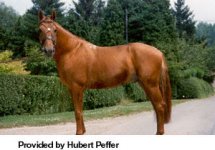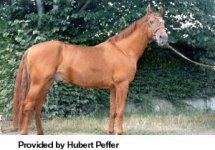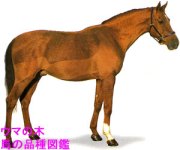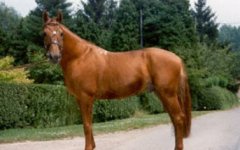♘امیرحسین♞
♘ مدیریت انجمن اسب ایران ♞
The Russian Don Horse serves superbly both in harness and under saddle. This breed was the mount of the famed and feared Cossack Cavalry. It was the Cossack's skill at breeding that made the Don such a rugged horse. The breed originated in the area near the Don and Volga Rivers in the southern Soviet Union. Originally, this was a small horse, but during the 1800's large numbers of the Persian Arabs and Karabakh breeds were bred to the Don. The result was a larger, more refined horse, which combined the durability of the older type and the more pleasing conformation of the imported stock. Traditionally, the Don has roamed in herds, enduring harsh winters with little food and only the heartiest have survived.
Physical Description
The Don Horse has a refined head with a straight or sometimes hooked nose, large nostrils, and expressive eyes. The neck is lean and often straight. The withers are not prominent; the shoulders are quite straight, giving the Don a rather short stride. Its chest is substantial and muscular. The back is long and the legs are clean. The Don stands between 15.1 and 16 hands and appears in varying solid colors such as chestnut, bay, and gray. The breed is noted for an even temperament and great powers of endurance.
Origin
The Don Horse, a native of the Soviet Union, gained its name from the region near the Don River where it has been bred since the 1700's. In the past two centuries, the original breed received blood from numberous other breeds including the Persian Arab, Karabakh, Orlov Trotter, and Thoroughbred.
Notes of Interest
The Don Horse's greatest characteristic is its incredible stamina. The Cossack Cavalry, which contributed to Napoleon's defeat in Russia, pursued the French all the way to Paris mounted on Don Horses. Few breeds could have withstood such a punishing task.
In 1951, a stallion named Zenith coverd 311.6 kilometers in 24 hours (including only 4 hours of rest).
In recent years, the Don has gained widespread respect as a saddle horse. It is still used in harness however, often in the traditional "Tachanka", a hitch in which four horses are harnessed side - by - side.
Physical Description
The Don Horse has a refined head with a straight or sometimes hooked nose, large nostrils, and expressive eyes. The neck is lean and often straight. The withers are not prominent; the shoulders are quite straight, giving the Don a rather short stride. Its chest is substantial and muscular. The back is long and the legs are clean. The Don stands between 15.1 and 16 hands and appears in varying solid colors such as chestnut, bay, and gray. The breed is noted for an even temperament and great powers of endurance.
Origin
The Don Horse, a native of the Soviet Union, gained its name from the region near the Don River where it has been bred since the 1700's. In the past two centuries, the original breed received blood from numberous other breeds including the Persian Arab, Karabakh, Orlov Trotter, and Thoroughbred.
Notes of Interest
The Don Horse's greatest characteristic is its incredible stamina. The Cossack Cavalry, which contributed to Napoleon's defeat in Russia, pursued the French all the way to Paris mounted on Don Horses. Few breeds could have withstood such a punishing task.
In 1951, a stallion named Zenith coverd 311.6 kilometers in 24 hours (including only 4 hours of rest).
In recent years, the Don has gained widespread respect as a saddle horse. It is still used in harness however, often in the traditional "Tachanka", a hitch in which four horses are harnessed side - by - side.




